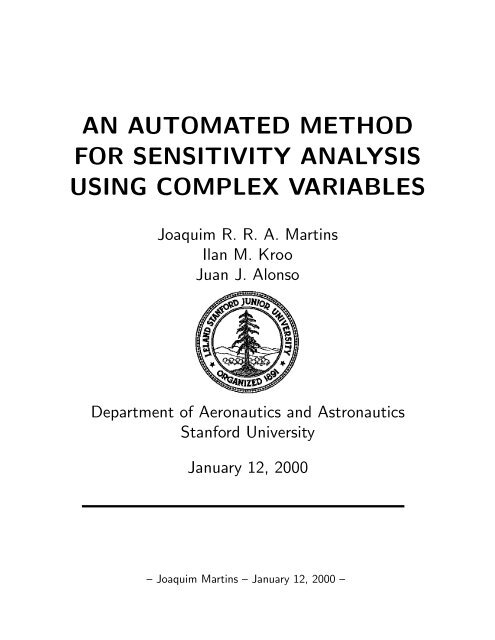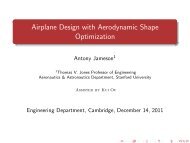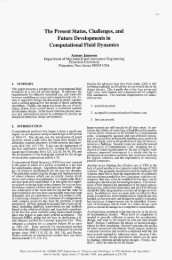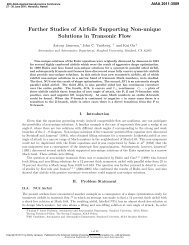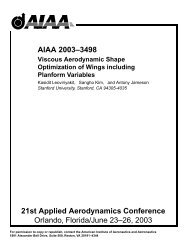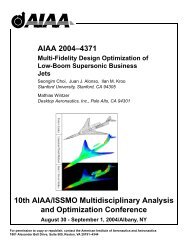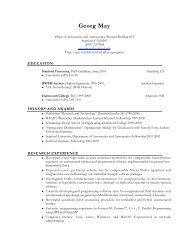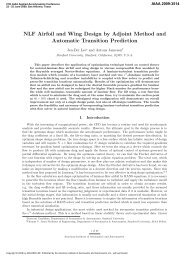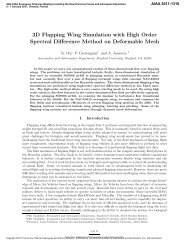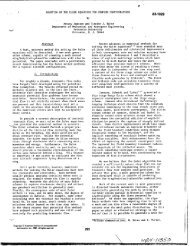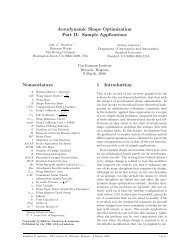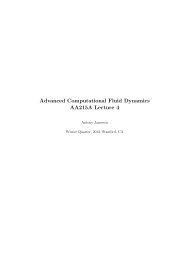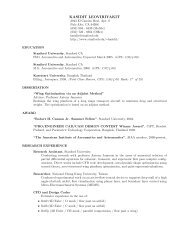x - Aerospace Computing Lab - Stanford University
x - Aerospace Computing Lab - Stanford University
x - Aerospace Computing Lab - Stanford University
Create successful ePaper yourself
Turn your PDF publications into a flip-book with our unique Google optimized e-Paper software.
AN AUTOMATED METHOD<br />
FOR SENSITIVITY ANALYSIS<br />
USING COMPLEX VARIABLES<br />
Joaquim R. R. A. Martins<br />
Ilan M. Kroo<br />
Juan J. Alonso<br />
Department of Aeronautics and Astronautics<br />
<strong>Stanford</strong> <strong>University</strong><br />
January 12, 2000<br />
– Joaquim Martins – January 12, 2000 –
Outline<br />
• Background on complex-step and other sensitivity<br />
analysis methods<br />
• Theory<br />
– First derivative approximations<br />
– Higher derivative approximations<br />
• Implementation of the complex-step in algorithms<br />
– Fortran functions and operators<br />
– Automatic implementation<br />
• Results<br />
– Structural sensitivities<br />
– Aerodynamic sensitivities<br />
• Conclusions<br />
– Joaquim Martins – January 12, 2000 – 1
Sensitivity Analysis Methods<br />
• Finite-Difference Methods<br />
• ADIFOR<br />
• Analytic Methods<br />
• Complex-Step:<br />
– Lyness & Moler, 1967:<br />
n th derivative approximation by integration in the<br />
complex plane<br />
– Squire & Trapp, 1998:<br />
Simple formula for first derivative,<br />
f ′ ≈ Im[f(x + ih)]/h<br />
– Newman, Anderson & Whitfield, 1998:<br />
Aero-structural code<br />
– Anderson, Whitfield & Nielsen, 1999:<br />
3D Navier-Stokes with turbulence model<br />
– Joaquim Martins – January 12, 2000 – 2
Finite-Difference Derivative<br />
Approximations<br />
From Taylor series expansion.<br />
• Forward-difference:<br />
f ′ (x) ≈<br />
• Central-difference:<br />
f ′ (x) ≈<br />
f(x + h) − f(x)<br />
h<br />
f(x + h) − f(x − h)<br />
2h<br />
+ O(h)<br />
+ O(h 2 )<br />
Any finite-difference formula subject to subtractive<br />
cancellation.<br />
– Joaquim Martins – January 12, 2000 – 3
Cauchy-Riemann Equations<br />
• Extension of rational numbers to solve x 2 = 2:<br />
Define w = a + √ 2b where a, b are rational.<br />
Derivative of f(w):<br />
∂f<br />
∂w<br />
= ∂f<br />
∂a = √ 2 ∂f<br />
∂b .<br />
• Extension of real numbers to solve x 2 = −1:<br />
Define z = x + iy, where x, y are real.<br />
Derivative of f(z):<br />
∂f<br />
∂z<br />
= ∂f<br />
∂y<br />
. Define f(z) = u(z) + iv(z),<br />
∂u<br />
∂x<br />
= ∂v<br />
∂y ,<br />
= i∂f<br />
∂x<br />
∂u<br />
∂y<br />
= −∂v<br />
∂x .<br />
Complex number really just one number.<br />
– Joaquim Martins – January 12, 2000 – 4
Complex-Step Derivative Approximation<br />
• From Cauchy-Riemann:<br />
∂u<br />
∂x<br />
= lim<br />
h→0<br />
v(x + i(y + h)) − v(x + iy)<br />
.<br />
h<br />
For a real functions of a real variable, y = 0,<br />
u(x) = f(x) and v(x) = 0, then,<br />
∂f<br />
∂x<br />
= lim<br />
h→0<br />
Im [f (x + ih)]<br />
.<br />
h<br />
• From Taylor series expansion, step ih:<br />
f(x+ih) = f(x)+ihf ′ (x)−h 2f ′′ (x)<br />
2! −ih3f ′′′ (x)<br />
+. . .<br />
3!<br />
⇒ f ′ Im [f(x + ih)]<br />
(x) =<br />
h<br />
No subtraction!<br />
+ h 2f ′′′ (x)<br />
3!<br />
+ . . .<br />
– Joaquim Martins – January 12, 2000 – 5
Simple Numerical Example<br />
• Estimate derivative at x = 1.5 of the function,<br />
<br />
<br />
<br />
<br />
<br />
<br />
<br />
<br />
<br />
<br />
f(x) =<br />
<br />
<br />
<br />
e x<br />
√ sin 3 x + cos 3 x<br />
ε = f ′ − f ′ <br />
<br />
ref / f ′ <br />
<br />
ref<br />
¢¡¤£¦¥§ ©¨£<br />
– Joaquim Martins – January 12, 2000 – 6
Higher Derivative Approximations<br />
• General form of Cauchy’s Integral,<br />
f (n) (z) = n!<br />
<br />
f(ξ)<br />
2πi (ξ − z) n+1dξ.<br />
• Discretize using a trapezoidal-rule, integrate around<br />
circle z + rei ,<br />
f (n) (z) ≈ n!<br />
<br />
m−1 f z + re<br />
mr<br />
i2πj<br />
<br />
m<br />
.<br />
Γ<br />
j=0<br />
ei2πjn m<br />
• Fixed r, use more points for better approximation.<br />
Bound on error.<br />
• With finite-difference, have to decrease h for better<br />
accuracy.<br />
• First derivative formula can be derived from this...<br />
...but it is the only one that does not involve<br />
subtraction.<br />
– Joaquim Martins – January 12, 2000 – 7
Complex Functions and Operators in<br />
Fortran<br />
• Relational operators<br />
– Used with if statements to direct the execution<br />
thread.<br />
– Complex algorithm must follow same thread.<br />
– Therefore, compare only the real parts.<br />
– Also, max, min, etc.<br />
• Arithmetic functions and operators:<br />
– Most of these have a mathematical standard<br />
definition that is analytic.<br />
– Some of them are implemented in Fortran.<br />
– Exception: abs<br />
∂u<br />
∂x<br />
= ∂v<br />
∂y =<br />
abs(x + iy) =<br />
<br />
−1 ⇐ x < 0<br />
+1 ⇐ x > 0<br />
<br />
−x − iy ⇐ x < 0<br />
+x + iy ⇐ x ≥ 0 .<br />
– Joaquim Martins – January 12, 2000 – 8
Overloaded Functions<br />
abs ✘ abs(z) =<br />
<br />
−z ⇐ x < 0<br />
+z ⇐ x ≥ 0<br />
tan ✔ tan(z) = e−iz−e iz<br />
e−iz +eiz asin ✔ arcsin(z) = −i log[iz + (1 − z2 ) 1 2]<br />
acos ✔ arccos(z) = −i log[z + (z2 − 1) 1 atan ✔<br />
2]<br />
arctan(z) = i<br />
2 log<br />
<br />
1−iz<br />
1+iz<br />
sinh ✔ sinh(z) = ez−e −z<br />
cosh ✔<br />
2<br />
cosh(z) = ez +e −z<br />
tanh ✔<br />
2<br />
tanh(z) = ez−e −z<br />
ez +e−z <br />
dim ✘<br />
z1 − z2<br />
dim(z1, z2) =<br />
0<br />
<br />
⇐ x1 > x2<br />
⇐ x1 ≤ x2<br />
sign ✘<br />
+|x1|<br />
sign(z1, z2) =<br />
−|x1|<br />
<br />
⇐ x2 ≥ 0<br />
⇐ x2 < 0<br />
max ✘<br />
z1<br />
max(z1, z2) =<br />
z2<br />
<br />
⇐ x1 ≥ x2<br />
⇐ x1 < x2<br />
min ✘ min(z1, z2) =<br />
z1<br />
z2<br />
⇐ x1 ≤ x2<br />
⇐ x1 > x2<br />
– Joaquim Martins – January 12, 2000 – 9
Automatic Implementation<br />
• Cookbook procedure:<br />
– Substitute all real type variable declarations with<br />
complex declarations.<br />
– Define all functions and operators that are not<br />
defined for complex arguments.<br />
– A complex-step can then be added to the desired<br />
variable and the derivative can be estimated by<br />
f ′ ≈ Im[f(x + ih)]/h.<br />
• Fortran 77: write new subroutines, substitute some<br />
of the intrinsic function calls by the subroutine<br />
names, e.g. abs by c abs. But ... need to know<br />
variable types in original code.<br />
• Fortran 90: can overload intrinsic functions<br />
and operators, including comparison operators.<br />
Compiler knows variable types and chooses correct<br />
version of the function or operator.<br />
• Complexify.py: Python script processes code.<br />
complexify.f90: overloaded definitions.<br />
– Joaquim Martins – January 12, 2000 – 10
Structural Sensitivities:<br />
Finite Element Solver<br />
• FESMEH, finite element solver used in MDO.<br />
• Triangular plates and truss elements.<br />
• Wing modeled with spars, ribs and skin.<br />
• Spars and ribs modeled with plates and trusses.<br />
– Joaquim Martins – January 12, 2000 – 11
Sensitivity Estimates vs. Step Size<br />
• Sensitivity of truss stress w.r.t. truss area.<br />
<br />
<br />
<br />
¢¡¤£¦¥§ ©¨£<br />
• Finite-difference: reasonable estimate, if you’re<br />
lucky...<br />
• Complex-step: practically insensitive to step size.<br />
– Joaquim Martins – January 12, 2000 – 12
Computational Accuracy and Cost<br />
Method Sample Sensitivity<br />
Complex –39.049760045804646<br />
ADIFOR –39.049760045809059<br />
Analytic –39.049760045805281<br />
FD –39.049724352820375<br />
• Finite-difference is worst.<br />
• Other methods achieve the solver’s precision.<br />
Method Time Memory<br />
Complex 1.00 1.00<br />
ADIFOR 2.33 8.09<br />
Analytic 0.58 2.42<br />
FD 0.88 0.72<br />
• Analytic: best, but not easy to implement.<br />
• ADIFOR: costly.<br />
• Complex-step: good compromise.<br />
• Caveat: ratios depend on problem.<br />
– Joaquim Martins – January 12, 2000 – 13
Aerodynamic Sensitivities: FLO82<br />
RAE 2822 Airfoil<br />
α = 3.0 o , M∞ = 0.70<br />
Cp<br />
1.20 0.80 0.40 0.00 -0.40 -0.80 -1.20 -1.60 -2.00<br />
+<br />
+<br />
++ +++++++++++++++++++++++++<br />
+<br />
+ + + +<br />
+<br />
+ + +<br />
+<br />
+<br />
+<br />
+<br />
+<br />
+<br />
+<br />
+<br />
+<br />
• 2D, cell-centered, finite volume Euler solver.<br />
• Multigrid.<br />
• Implicit residual smoothing.<br />
+<br />
+<br />
+<br />
+<br />
+<br />
+<br />
+<br />
+<br />
+<br />
+<br />
+ +++<br />
+<br />
+<br />
+<br />
+++ ++++++++++++++++++++++++<br />
• Artificial dissipation options: JST, CUSP, ECUSP<br />
and HCUSP.<br />
• Same numerical schemes as FLO87 and FLO107.<br />
– Joaquim Martins – January 12, 2000 – 14<br />
+ +++++ ++++++++++++++++++++++
Normalized Error, ε<br />
10 0<br />
10 −2<br />
10 −4<br />
10 −6<br />
10 −8<br />
Sensitivity Estimates vs. Step Size<br />
10 −10<br />
∂CD/∂M∞<br />
10 −20<br />
Step Size, h<br />
Complex−Step<br />
Finite−difference<br />
10 −30<br />
– Joaquim Martins – January 12, 2000 – 15
Residual<br />
Convergence of Sensitivity Estimates<br />
10 10<br />
10 5<br />
10 0<br />
10 −5<br />
Complex−Step<br />
Finite−difference<br />
Average density residual<br />
10<br />
0 50 100 150<br />
−10<br />
Number of Iterations<br />
• Both estimates converge at same rate as solver.<br />
– Joaquim Martins – January 12, 2000 – 16
Aerodynamic Sensitivity Results<br />
Sensitivity Complex FD<br />
∂CL/∂α 12.37054751691092 12.3707266652<br />
∂CD/∂α 0.8602380269441042 0.86024234610<br />
∂CM/∂α –0.5026301652982372 –0.5026313670<br />
∂CL/∂M∞ 3.2499722985150532 3.24994475775<br />
∂CD/∂M∞ 0.43978671505102005 0.43978998888<br />
∂CM/∂M∞ –0.99037388394690016 –0.9903747405<br />
• Imaginary part of result converged to the same number of<br />
real part.<br />
– Joaquim Martins – January 12, 2000 –
Drag Coefficient Sensitivity<br />
11<br />
10<br />
9<br />
8<br />
7<br />
6<br />
5<br />
4<br />
3<br />
2<br />
1<br />
0<br />
Drag Coefficient Sensitivity to<br />
Hicks-Henne “Bump” Functions<br />
Complex−Step<br />
Finite−difference<br />
10 20 30 40 50<br />
Design Points<br />
Method Time Memory<br />
Complex 1.00 1.00<br />
FD 0.31 0.55<br />
– Joaquim Martins – January 12, 2000 – 18
Conclusions<br />
• The theory behind the application of the complexstep<br />
method to real-world numerical algorithms was<br />
introduced.<br />
• The implementation of the complex-step method<br />
was successfully automated.<br />
• The sensitivity results given by this method have<br />
been further validated and shown to be very<br />
accurate.<br />
• Unlike finite-differencing, the complex-step method<br />
is relatively insensitive to the step size.<br />
• The complex-step method is now an attractive<br />
alternative to ADIFOR.<br />
– Joaquim Martins – January 12, 2000 – 19
Further Work<br />
• Continue to work on Complexify.py.<br />
Need feedback from users.<br />
• Apply the method to other solvers.<br />
• More detailed stability and convergence analysis.<br />
• Compare with CFD adjoint results.<br />
– Joaquim Martins – January 12, 2000 – 20


